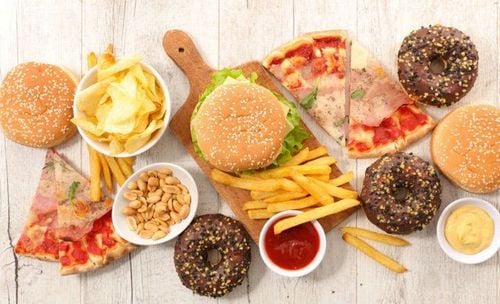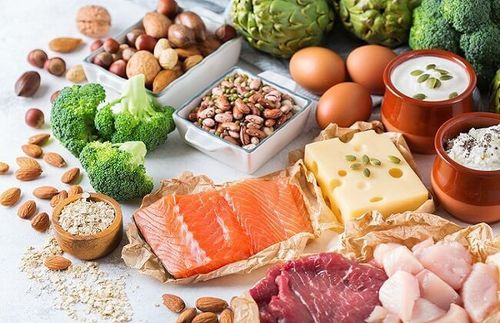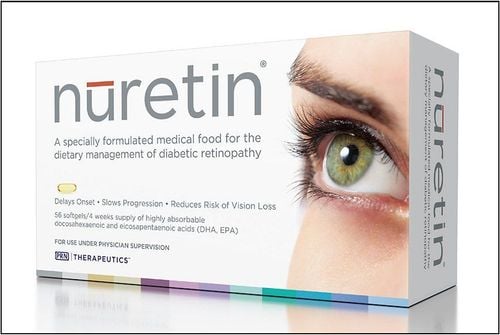This is an automatically translated article.
Eating a variety of foods is an option to help your body enjoy a variety of flavors. However, with that variety comes a reasonable diet. So what are the main food groups that you need to learn about when following a healthy diet?1. 5 food groups that should be included in a varied menu
Based on nutritional composition and body needs, experts have divided foods into 5 main groups:Vegetables and legumes Fruits Lean meat, poultry, fish, eggs, milk, beans and other foods. bean products Cereals, whole grains Milk and products derived from milk. Foods that are divided into the same group will have largely the same source of nutrients. For example, in the group of milk and dairy products (butter, cheese ..) will provide mainly calcium and protein for the body. The group of vegetables and fruits contain a rich source of vitamins, especially vitamin C, which is good for the body's resistance.
A reasonable nutrition balanced with 5 main food groups is always a difficult problem for each of our meals. Each food is a mixture of different nutrients and each substance is important and beneficial for health.
Therefore, under the division based on the main nutrient composition of foods into 5 main groups, you will be able to create many different options. Each meal, you eat a variety of foods, the body will have a sense of appetite and increase metabolism better.

Một chế độ dinh dưỡng hợp lý được cân bằng với 5 nhóm thực phẩm chính luôn là bài toán khó cho mỗi bữa ăn của chúng ta
2.Some other food groups need attention
Besides the 5 main food groups, foods are also divided into 2 groups that are foods that should be used with low frequency and foods that provide positive sources of fat.2.1 Foods to eat in low frequency Nutritionally they can be placed in 1 or more of the 5 main food groups. However, in general, this food group should only be used sparingly and occasionally. It can also be called a group of snacks or fast food for busy people and school age.
This food group tends to contain a lot of sugar and saturated fat, which increases the body's calorie needs. Too much saturated fat is difficult to metabolize, causing the body to fall into a state of overweight and obesity. Moreover, this is the main cause of blood fat, heart disease and even cancer.
Some examples of unhealthy snacks frequently used:
Cakes, desserts, biscuits Meats prepared into fast foods such as cold cuts, smoked meats, sausages Sausage... Condensed milk Sweetened ice cream and confectionery Sweet chocolate Alcoholic and carbonated beverages Pre-fried foods such as french fries, fried chicken.. Butter, cheese topped with foods This is Food groups are not recommended to use much, so you can use them to supplement or fight a fire in case of an emergency that cannot be cooked in time. If you replace healthy nutrition from fresh foods with processed fast foods, your body will soon face the risk of cardiovascular disease, stroke, diabetes more serious than cancer.

Thực phẩm chiên sẵn như khoai tây chiên, gà rán không được khuyến khích sử dụng nhiều
For adults, 1 to 2 tablespoons of fat per day is enough and good for health. Unsaturated fats (positive fats) are an integral part of a healthy diet. When provided with adequate fat, it will help the body to increase the absorption of vitamins (A, K, E and D), reduce the risk of cardiovascular disease and at the same time inhibit the development of bad cholesterol.
Unsaturated fats are divided into 2 main groups: monounsaturated fats and polyunsaturated fats. Monounsaturated fats are provided by: oils and oilseeds. Polyunsaturated fats are also known as omega 3 6 -9 unsaturated fats.
Replacing saturated fat with unsaturated fat is a method to help improve diseases caused by saturated fat. You can eat butter instead of ice cream, but choose olive oil or margarine for a healthy source of fat.
3. The need to eat a variety of foods according to each target group
Eating a variety of foods is a way to improve health for all ages. However, how much is enough to eat, is, how to know what the body needs to be provided with? We need to consider many factors such as age, gender, job characteristics....Children under 2 years old: 40 grams of cereal; 20 - 30 grams of seeds and legumes; 5 grams of fruit; 10 - 15 grams of milk and dairy products; 10 grams of lean meat, fish eggs... Children from 2 to 3 years old: 40 grams of cereal; 25 grams of seeds and legumes; 10 grams of fruit; 15 grams of milk and dairy products; 10 grams of lean meat, fish eggs... Children from 4 to 8 years old: 40 grams of cereal; 45 grams of nuts and legumes; 15 grams of fruit; 15 grams of milk and dairy products for girls and 20 grams for boys; 15 grams of lean meat, fish eggs... Children from 9 to 11 years old: 40 grams of cereal for girls and 50 grams for boys; 50 grams of nuts and legumes; 20 grams of fruit; 30 grams of milk and dairy products for girls and 25 grams for boys; 25 grams of lean meat, fish eggs... Teenagers from 12 to 13 years old: 50 grams of cereal for girls and 60 grams for boys; 55 grams of nuts and legumes; 20 grams of fruit; 35 grams of milk and dairy products; 25 grams of lean meat, fish eggs... Teenagers from 14 to 18 years old: 70 grams of cereal for; 55 grams of nuts and legumes; 20 grams of fruit; 35 grams of milk and dairy products; 25 grams of lean meat, fish eggs... Children under 18 years of age are in the process of pregnancy: 80 grams of cereals for; 50 grams of nuts and legumes; 20 grams of fruit; 35 grams of milk and dairy products; 35 grams of lean meat, fish eggs... Children under 18 years of age are breastfeeding: 90 grams of cereals; 55 grams of nuts and legumes; 20 grams of fruit; 40 grams of milk and dairy products; 25 grams of lean meat, fish eggs... Women and men of each age also need to be provided with nutrients in 5 different main groups.

Phụ nữ và nam giới theo từng độ tuổi cũng cần được cung cấp dinh dưỡng theo 5 nhóm chính khác nhau
Women 19 to 50 years old: 60 grams of cereal for; 50 grams of nuts and legumes; 20 grams of fruit; 25 grams of milk and dairy products; 25 grams of lean meat, fish eggs... Women 51 to 70 years old: 40 grams of cereal for; 50 grams of nuts and legumes; 20 grams of fruit; 40 grams of milk and dairy products; 20 grams of lean meat, fish eggs... Women over 70 years old: 30 grams of cereal for; 50 grams of nuts and legumes; 20 grams of fruit; 40 grams of milk and dairy products; 20 grams of lean meat, fish eggs... Men:
Men 19 to 50 years old: 60 grams of cereal for; 60 grams of nuts and legumes; 20 grams of fruit; 25 grams of milk and dairy products; 30 grams of lean meat, fish eggs... Men 51 to 70 years old: 60 grams of cereal for; 55 grams of nuts and legumes; 20 grams of fruit; 25 grams of milk and dairy products; 25 grams of lean meat, fish eggs... Men over 70 years old: 45 grams of cereals; 50 grams of nuts and legumes; 20 grams of fruit; 35 grams of milk and dairy products; 25 grams of lean meat, fish eggs...
4. Scientific daily servings for each food group.
Vegetables and legumes Every day the body needs to provide about 75-100 grams of vegetables to have 100-350 calories. With this amount you can eat a cup of salad, eat a medium tomato or half a cup of boiled vegetables, half a potato....Fruits An average serving of 150 grams of fruit will give you 350 calories. For dried fruit or low-sugar fruit, the amount used will be adjusted up or down according to demand. You can also consult a nutritionist.
Lean meat, poultry, fish, eggs, milk, beans and bean products A standard serving of meat, fish, eggs .. needs to provide 500 - 600 calories for the body. However, each type of meat and food has different calories, so when using it, you should look up or consult a nutritionist for balance.
Grains, whole grains Cereals are a high-fiber food group and each standard serving will need to provide only 500 calories. You can use 1 slice of bread, 75-120 noodles or 30 grams of cereal for breakfast....
Milk and dairy products Milk and dairy products provide the body with fat. , calcium and protein. You can use them every day to ensure energy for work and refined nutrition for the body when too busy.

Sữa và các chế phẩm từ sữa cung cấp cho cơ thể chất béo, canxi và protein
5. The importance of eating a variety of foods
Both lack of nutrients or excess lead to diseases. Therefore, eating a variety of foods is not simply about creating a delicious and interesting meal for each meal. Eating a variety of foods from many nutritional groups helps to provide the body with adequate nutrients.From there, all metabolic activities of the organs also move better. As a result, the risk of disease caused by invading viruses or weakened resistance is also significantly reduced.
Proper nutrition is always an issue that needs special attention and attention when choosing food for each family meal. If you still have doubts, please contact a nutritionist for a specific examination and advice on the best diet for your body.
Please dial HOTLINE for more information or register for an appointment HERE. Download MyVinmec app to make appointments faster and to manage your bookings easily.
Reference source: betterhealth.vic.gov.au












